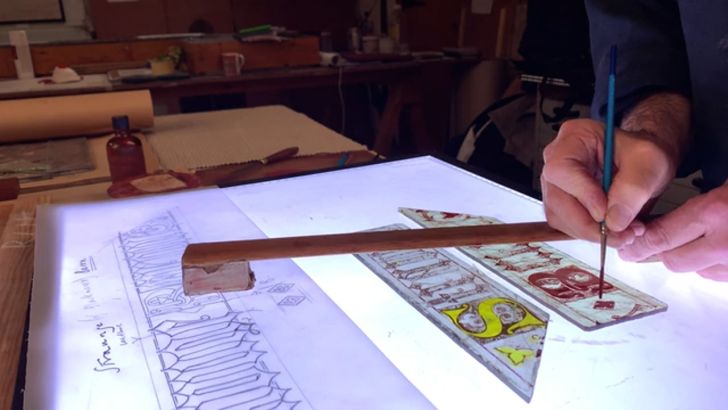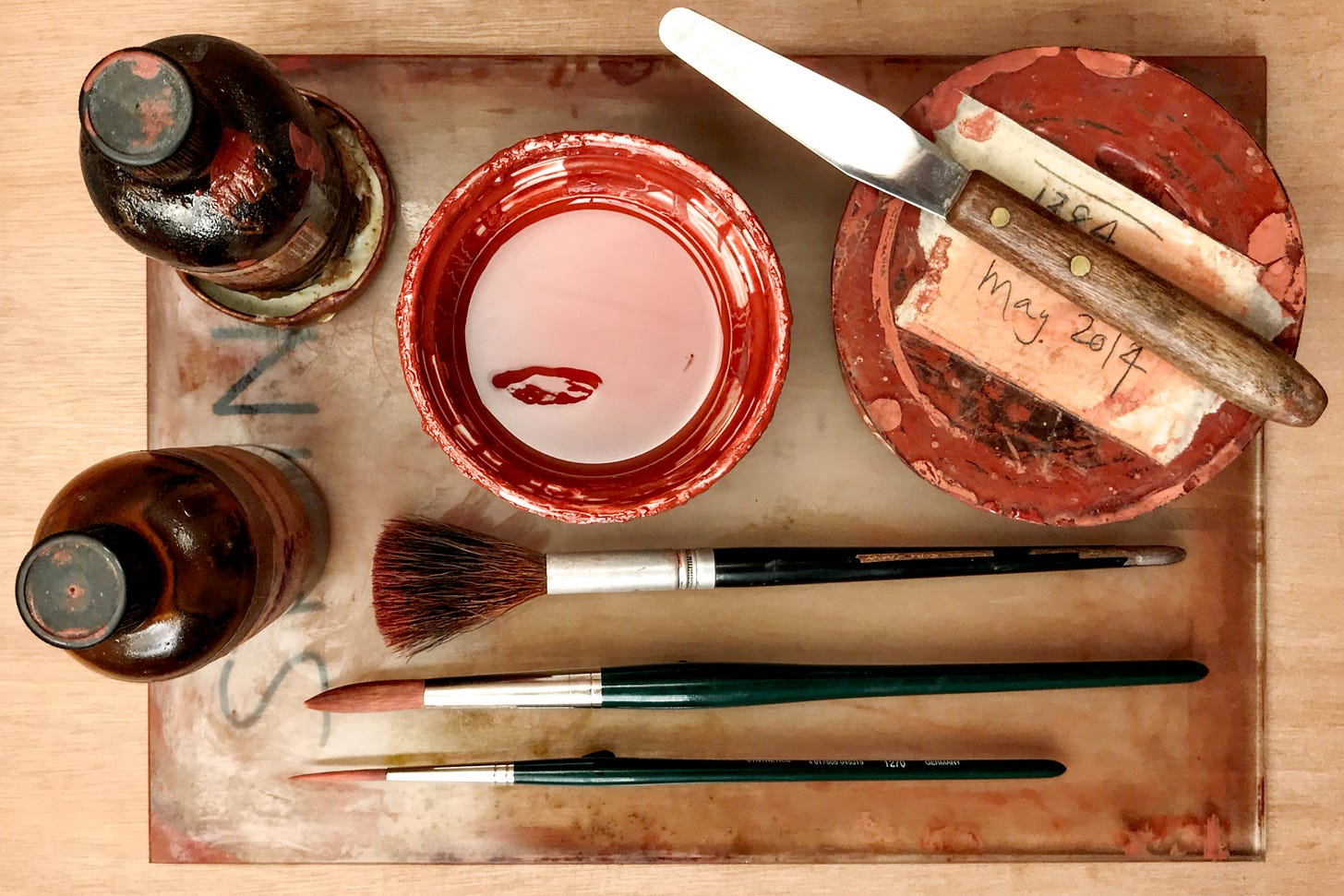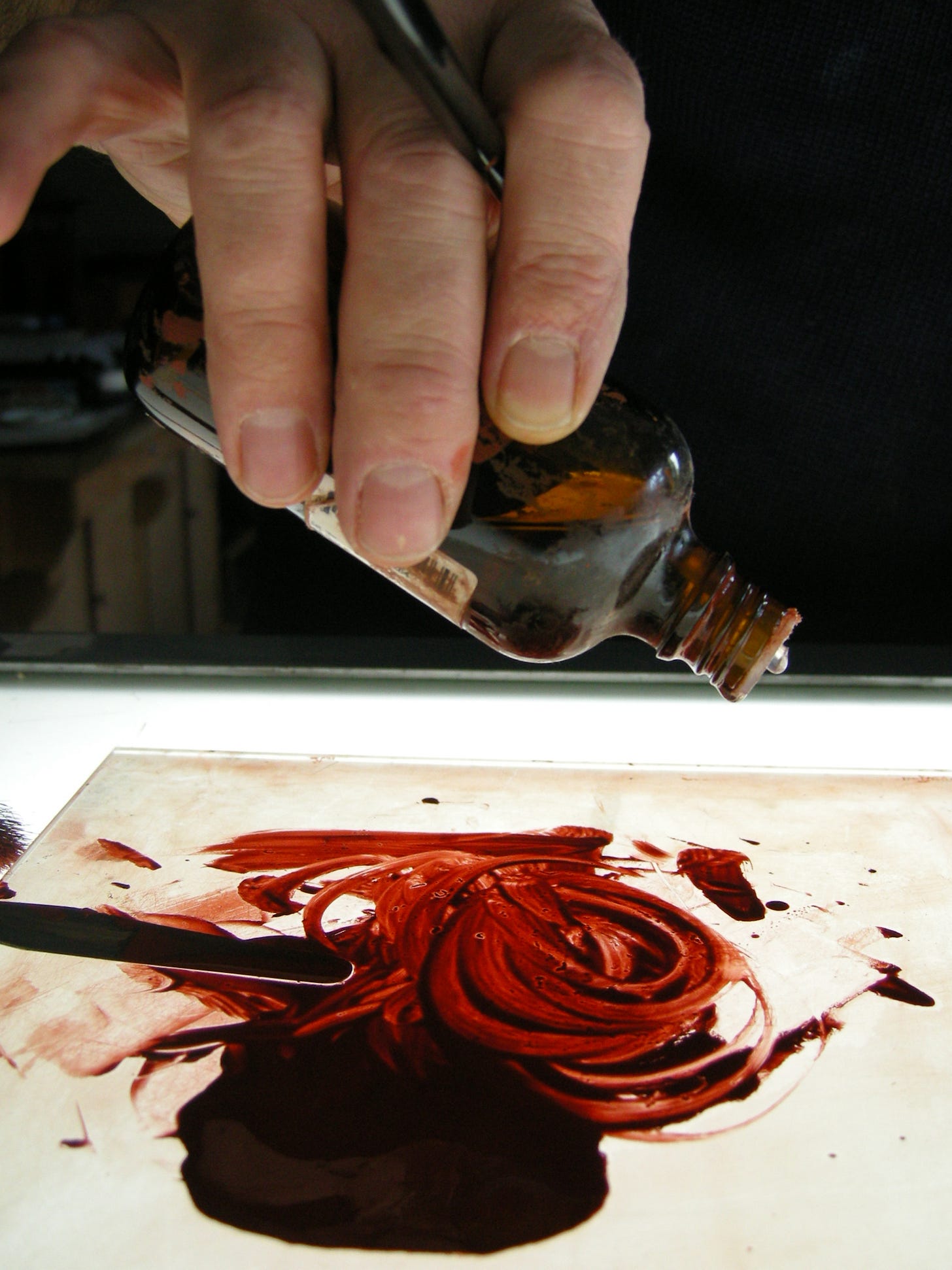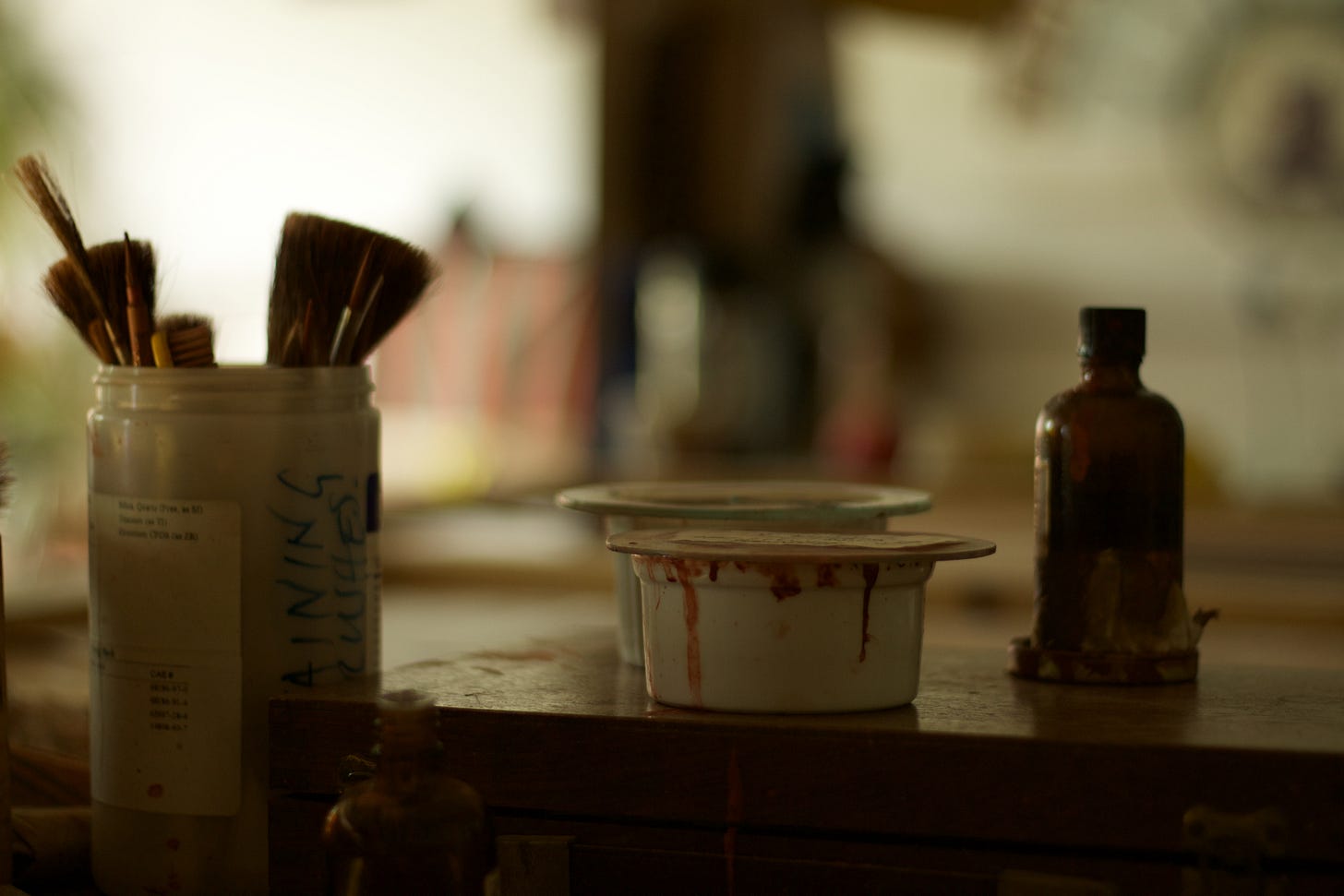I am not an anxious person. However I am concerned you might misjudge the autocratic tone with which I sometimes write — “First do this and then do that and then do this …” — as if I think our methods might be the only way to restore or paint stained glass: as if I am a dogmatist.
Though there are interpretations of my actions which might offend the sense I have of what I stand for, this one most certainly does not (because, for reasons I can state, it’s got a heavy case against it). But I feel obliged to tackle it today because I judge it threatening to the purpose of my correspondence with you.
Namely:
Clearly to describe a path across the wide domain of stained glass painting so that newcomers — especially quiet, careful, unassuming newcomers, whom, for just these qualities, no contemporary Institute for Art will ever likely welcome to its bosom — can make their own deep way within, and there engage their eyes and hands, and discover many fruitful paths unknown to me.
Particularly as concerns the topic of this current letter, I sense an opportunity if not to prove, then at least to indicate my innocence. I sense I can entwine my evidence around the theme of silver stain …
… silver stain which fortuitously you can apply by flooding, that same method I discussed with you last time I wrote albeit in a different context; which serves to show how useful you’ll likely find the skill once you have mastered it.
Now those of you who’ve read the literature will grasp immediately that this method of applying stain — flooding — though achievable with practise, ought not (assuming that the literature is accurate: a wild assumption, as you will see) to be the way to teach a newcomer.
Yet I suggest it is.
Suggest — there! I’ve toned down my strident way of speaking. (Just don’t imagine I might manage it for long. My choice since boyhood has always been for Othello’s directness over Iago’s guile, though it has won me many enemies and earned me but few friends.)
Here I provide five examples from the literature so I might start to make my case. This is of course a stitch-up. Kindly therefore note what’s common to them all:
“Stain is mixed with gum and water in the same way as brown glass paint” (Stained Glass; L. Lee, G. Seddon & F. Stephens; Spring Books; 1976 and 1989; p. 184).
“Mix the silver stain on a glass palette with water and a firm palette knife” (The Art Of Painting On Glass; Albinas Elskus; The Glass Press; 1980; p.98).
Silver stain “should be mixed with water and ground carefully with a palette knife” (Stained Glass Craft; J.A.F. Divine & G. Blachford; Dover Publications; 1940 and 1972; p. 84).
“A small portion of stain is piled on to the middle of the stain palette … A very little water is added, the stain falling in the middle” (The Technique Of Stained Glass; Patrick Reyntiens; Batsford Ltd.; 1967; p. 80)
“We do not mix the stain with water before grinding because we find it gives us less control” (How To Work In Stained Glass; A. and S. Isenberg; Chilton Book Company; 1972 and 1983; p. 190).
Yes, you guessed correctly: the answer’s water.
Here then is the rub: stain mixed with water is not usually or easily applied by flooding.
Certainly you’d apply it as precisely as you could. But, since water quickly dries, you’d find yourself obliged to rush, likely with a mop or squirrel-haired applicator brush, and you’d therefore often be inaccurate. Once applied, and always rushed onwards by evaporation, you’d hurry with your blender to regularise the stain, or shade it, or push it quickly into areas that you’d missed. Then you’d set the piece aside to dry. And then you’d use a stick to pick it back and give your stain the precision you had conspicuously failed to attain in application. (If you have never done this, you cannot yet imagine what it is to truly waste your precious time on Earth.)
But what do we see here?
I won’t say “leisurely” but I will say it’s un-hurried because this medium doesn’t make you hurry. And so you can be accurate in your application. Therefore there’s no need for picking back. I’ll show this to you shortly.
Even if silver stain were new to you, you might still feel confident to hypothesise that the medium you’ve just seen briefly demonstrated is unlikely to be water.
And you’d be right.
Besides, with those five quotations I gave you earlier (and especially if you know how disinclined I am to consensual thought), you are licensed to suspect I’m setting up a dragnet for my chosen prey.
Indeed, ladies and gentlemen, the conviction is as if branded on the same dear hand I paint with: that even the most celebrated experts in the field might not just employ but also recommend methods which, when you consider them objectively, will baffle your understanding and could benefit from disobedience.
It’s not that experts ever stop thinking.
Rather, like the humans that they are, they might not stop to think as often as you would hope if you were seeking their advice.
Water, the literature instructs — always water.
Always? Why always? Am I expected to abandon reason? To believe that nothing else will do? To imagine that all liquids except for water will inhibit the reaction which silver nitrate is apt to cause within the molecules of our glass?
Don’t be surprised I sound incredulous, even bitter: I well remember how I was mocked and scorned for wondering,
“Surely, other media will also work with stain. An oil, for instance. How else did Eames achieve his miraculous shading, or the Flemish medieval masters apply their stain with such extraordinary delicacy?”
But “New boy, just do as you’re instructed” was always the reply, accompanied in short order by “That’s how I was taught”, “I read it in a book”, “All the experts say to do it this way” and the particularly infuriating “That’s just how everybody does it”.
I even have a firm and shocking memory of a superb painter saying to me:
“Stain will not work with oil”.
And the reason this memory still shocks me? A living, breathing, thinking human being made up this claim — “made up” because the claim is simple to refute — possibly in order to sustain his sense of power, or because he objected to my manner (which I would never blame him for: unless someone values direct speech, he will be inclined to consider me tactless and insensitive). But so corrupting and possessive were this painter’s cravings, that his ability to think, at least on this point, was diminished to near-extinction. It is terrible to be near someone who’s in such a state; when it happens — am I alone in thinking it happens quite a lot? how often do I too make up assertions? — I feel unclean for days.
This carried on with stain and other matters until we at last both left the rat-infested and embittered studio where I apprenticed and set up a studio of our own where we put time aside each week to make experiments.
This being my experience, I hope it starts to seem to you discreditable that, whatever my didactic way of writing, I should likely ever mean, “This is the only way to do it”.
Certainly, if it happened that you were standing close to me when I was acid-etching …
… I would not mince my words. However, I would never think it was impossible for you to suggest a better way of doing things.
All of which I hope suggests that when I sound peremptory and autocratic in my style — “first do this, second do this, third …” — I am still but seeking to describe the steps which work for us.
I know full well these steps are not eternal truths. I know full well how my account of them cannot approach the precision of a chemical assay or the clarity of even an informal arithmetic proof.
And I also know I don’t know where it is that you, dear reader, want to go.
In short, notwithstanding my commitment to you, I know there is an almost terrifying quantity of work that you yourself must do. All I can do is open our doors, invite you in, and say to you, “This is how we work. Follow our steps, rehearse them till you are fluent, then please improve them in every way you can: for then I’ll know you paid attention, not only to my words but also to the brush and glass and paint or stain in front of you”.
In that spirit, long after we had tested lots of glass, I would like to show you how we stained the inscription — the honorific “Baron” as in “Straunge Baron” — for the window whose restoration is the topic of this present strand of letters to you:
The recipe is a thick paste of Sandalwood Amyris (which is not a real Sandalwood), sometimes also called Torchwood, combined with stain and thinned with Lavender.
Although, for the kind of work we do, these two oils are our most frequent choice, I urge you to consider that different media will also have a purpose in different situations — vinegar or glycol, for instance.
And there will be many other liquids you might work with: the other week, M. Hugo Baillargeon wrote to us from Canada to describe some glorious results he obtained with gold size thinned with mineral spirit. Ourselves, we’d never thought to try this, which only goes to show there’s always room for more discovery.
Also consider this excerpt from a 13th-century manuscript:
“And if they grind it and knead it with honey and smear glass with it and fire it, it stains the glass a very beautiful golden colour” (Lapidario, quoted in Stained Glass In England; June Osborne; Sutton Publishing; 1981 and 1997; p. 41).
Honey: who’d have thought it?
Yet the strangeness is just a symptom of my ignorance and isolation: it never occurred to me to try, though there always is a pot of honey in the cupboard at the studio.
Again I ask you, although I sound dogmatic, is it creditable that I really am? (If you had asked me about honey, I know I would have said, “I do not know”. Which is a far cry from claiming it cannot work.)
I will leave you with this 15-minute teaching video I’ve extracted from our online course on silver stain, in which you see a different brush in use:
Until the next time that I write, farewell, and may God speed you onward to a host of fine discoveries of your own.









A master class! Thank you.
Dear Masters, it’s an honour to be cited by you. None would have been accomplished without you. Thank you !